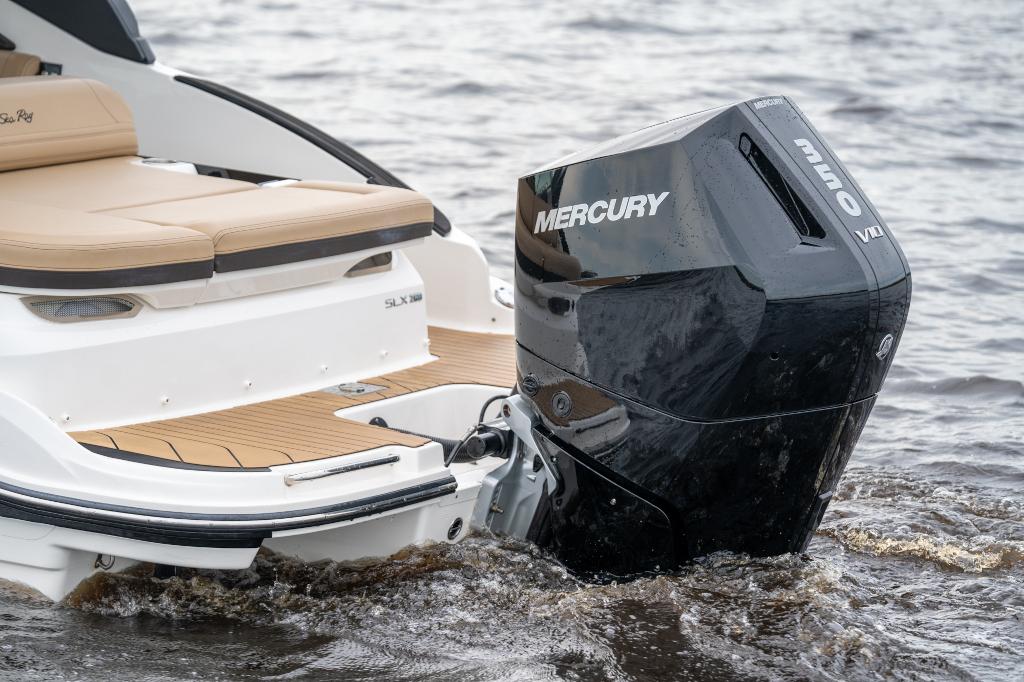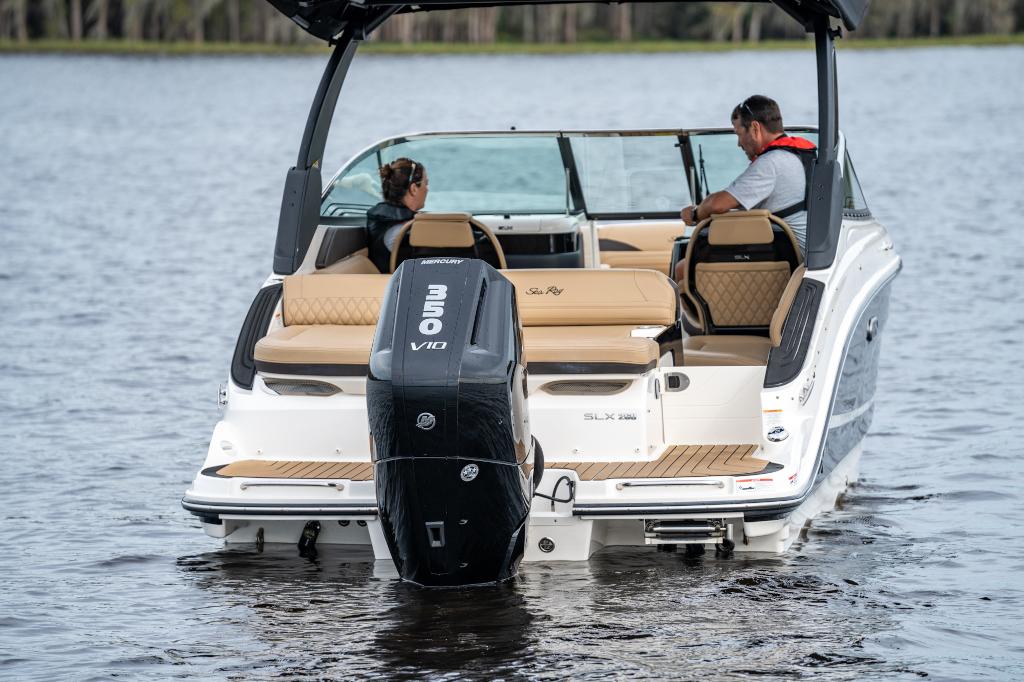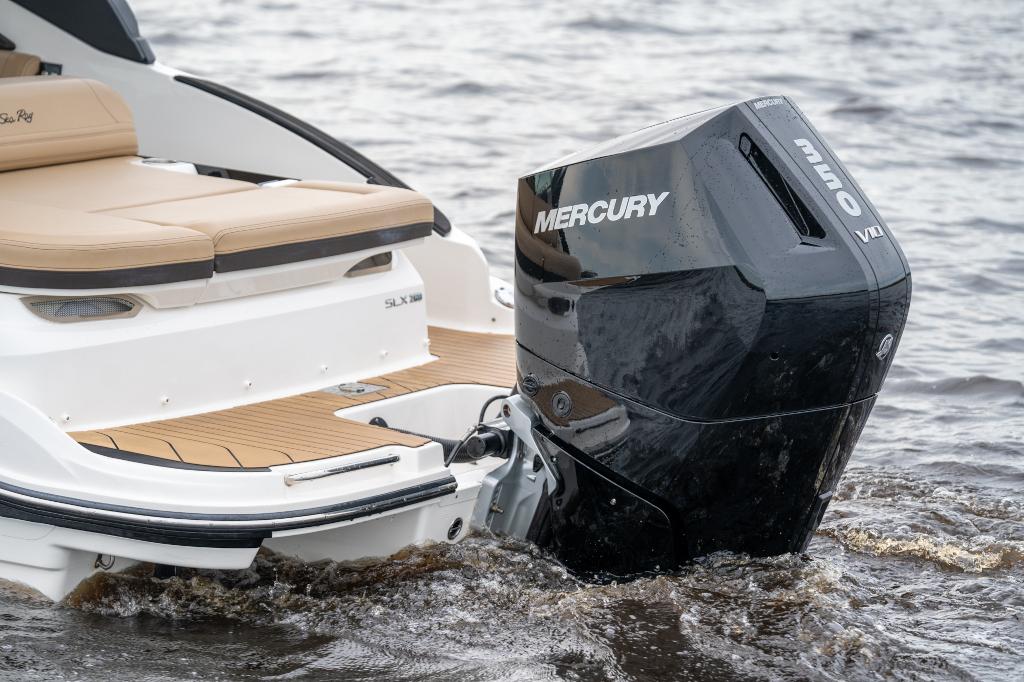First drive: 350hp Mercury V10 Verado

There’s no replacement for displacement when it comes to Mercury’s new 350hp V10 Verado
Mercury has introduced an all-new generation of 350hp and 400hp Verado engines featuring an innovative V10 block that weighs less than rival offerings.
Overview
From: boatsales.com.au
Article written by: Barry Park
Mercury’s almost decade-long love affair with its supercharged 350hp and 400hp 2.6-litre Verado in-line six-cylinder engines is about to end. While the Mercury Racing version will live on for a bit longer – its replacement could be announced at February’s Miami Boat Show – the premium recreational engine has fallen to a new rival, an all-new 5.7-litre bent 10-cylinder atmo engine.
Rather than rewriting history, the new Mercury V10 Verado engine returns to it. Mercury’s V6 and V8 engine range on which the new V10 is based, and the V12 that it shares some of its DNA with, all use big-displacement blocks that deliver good torque spreads and plenty of power with less complexity and fewer moving parts compared with the huffed six.

Mercury invited boatsales.com.au to its top-secret proving ground, Florida’s Lake X, to jump on board and try the new engines. One boat stood out as being particularly relevant to the Australian market – a Sea Ray SLX 260 OB wearing the 350hp version of the new Mercury V10 Verado.
Design specs
One of the benefits Mercury has over its rivals is that any engine it produces is the engine it wants. Rather than adopt an automotive engine for marine use, it sets its own performance benchmarks and builds the exact engine it would like.
In this case, Mercury wanted torque to replace a highly strung six-pot engine that was artificially stuffing air into its cylinders to minimise the need for the engine to build vacuum, getting more performance from lower in the rev range.
To do that, it had to think big. The plan was to add another two cylinders to its 4.6-litre V8 to create a 5.7-litre oversquare engine featuring a big bore and short piston stroke. It’s a combination that makes for a good high-revving, powerful unit.
The new V10 is built on the same production line in the US state of Wisconsin as Mercury’s V6 and V8 engines. It has a narrow 64-degree bank.

You’d think a big V10 would add a lot of weight and bulk to a boat’s transom, but while the engine does have a bigger physical footprint than the outgoing inline six, it still weighs less than equivalent rivals. This focus on weight goes as far as using plastic plugs to cap the ends of the hollow crankshaft to stop oil from entering them – oil in the shaft would give it more mass, making it slower to come up to speed.
Even the engine’s cowling is made from a new-generation composite that sheds significant weight compared with Mercury’s other engines – bearing in mind that some of Mercury’s engines needed thicker cowlings on them to add weight. That explains why some of Mercury’s V6s required a bit of effort to remove the top cowling.
In another big move, because this engine produces plenty of torque – Mercury politely declines any requests to show how much and where in the rev range – the new engine swings a much bigger prop that’s 35 per cent larger than the one used on the supercharged I6. How big? It’s easily as large as the primary unit on the 600hp twin-prop Mercury V12 Verado. The new prop helps with low-speed control and provides more bite to improve hole shot performance.
The engine uses two cams per bank, with a narrow 64-degree bank angle that matches the other bent engines in Mercury’s line-up. Most automotive applications for V10s use either a 72- or 90-degree bank angle for a more natural balance, so for Mercury to squeeze the banks even closer using a single harmonic balancer is quite a remarkable feat of engineering.

These cams drive two input and two exhaust valves, meaning the V10 has 20 valves per bank for a total of 40.
Of note, this engine uses the same mounting holes as the V8 – in fact, the mounting bracket is the same for both engines. However, the V10 is mounted around 2.5cm higher on the transom than the V8. The engine’s “advanced midsection”, known as AMS, includes rubber mounts that are designed to twist and put more rubber in contact with the engine cradle, smoothing out vibration.
Because of the larger prop, the Mercury V10 Verado also uses a unique gearcase with a two-stroke-like 2.08:1 gear ratio and a 6.4-inch torpedo. The torpedo – the section of the gearcase in front of the prop – is so large that it provides positive lift, giving the V10 an added bonus when rising up onto the plane.
Mercury has future-proofed the new V10 Verado for a new generation of energy-independent boats that will use banks of lithium-ion batteries to replace gensets. The default alternator will produce 90 amps at idle and 150 amps when running, but plans are afoot to add a switchable 12/48-volt alternator that will produce around 6500kW of battery-bankable electricity per engine.

Future plans also include adding Mercury’s own electric-assist power steering to the engine sometime next year to allow it to fully integrate with the boat’s electronics.
Like the V12, the Mercury V10 Verado engine has done away with the telltale. It’s because the engine is so quiet, the sound of the telltale hitting the water stood out like the proverbial dog’s balls, detracting from the perceived quality Mercury was aiming to hit with this engine. Not to mention, no one yet has asked for it to be included on the 600hp Mercury V12 Verado.
Price and equipment
Because the Mercury V10 Verado is an engine made for stacking on transoms, it will be available in four shaft sizes ranging from the standard 508mm (20-inch) through to a very deep 889mm (35-inch).
Mercury has also decided from the get-go that this engine will be available in black or white, with a choice of five coloured accents to make it look bespoke. You can also fully customise the paint job if the budget is big enough.
The engine is still some time away from arriving in Australia – at the moment it’s likely to land here in around April 2023 – so pricing is still a long way from being locked in. However, more physical mass means more price, so we can expect what we were told would be a modest price rise over the circa-$50,000 huffed I6.
This smarter engine can make do without Mercury’s VesselView gauges and displays because it is now fully compatible with Simrad multifunction displays.

The engine includes the beefy 12V/150A alternator that will one day also patch on the ability to pump out 48 volts to a bank of batteries that can run everything from airconditioning units to gyroscopic stabilisers without the need for an onboard genset. The alternator can sense when it is in demand, and at idle can automatically tell the engine to increase its revs to provide more charging grunt.
A stainless steel propeller – it even gets its own name, the Revolution X – will be included as standard. The engine uses its own prop with an extra set of exhaust vents added to the low-pressure side of the blade – on other engines they are just on the high-pressure side – to help with reversing. You can use grommets to change the size of the holes to tune how well the boat backs up.
Mercury has built electronic smarts into this engine that make it a lot smoother to use. Called Adaptive Speed Control, the system will automatically adjust the revs to keep a constant speed while turning, or while towing. The engine also fully integrates with Mercury’s Joystick Piloting for Outboards, although only for multiple installations.
The engine is built with an electronic oil sensor that will alert the helm if the oil level drops too low. If you like physically checking the dipstick, the Mercury V10 Verado has an access hatch on top of the cowl that opens at the press of a button hidden on the side of the upper cowl – it’s not push-open, push-shut like on the V8 and V12.
The engine’s design means you don’t need to remove the cowling to add or change the oil.
Maintenance touchpoints are all colour-coded so that you can locate and inspect them. The new engine also has Mercury’s new flushing system that simplifies the process to a single hose connection in the cockpit.
Power and performance
The Mercury V10 Verado is perfect for powering deep vee boats anywhere from 6.0 metres up. The engine’s narrow bank angle means it is also optimised for multi-engine applications to power larger boats.
Mercury had a number of single- and multiple-engine boats fitted with the new engine range at Lake X, its Florida-based proving ground where generations of engines have been refined to become the products we see today.
While all the multi-engine applications tap the 400hp version, we’re jumping on board the Sea Ray SLX 260 OB fitted with the 350hp V10 Verado.
The SLX 260 OB is one of the newest models in Sea Ray’s line-up, and a perfect luxury leisure boat for the Australian market. While this boat wears the new 350hp Mercury V10 Verado, it can also come with a 350hp MerCruiser/Bravo 3 sterndrive.
The new V10 looks imposing on the back of the Sea Ray, standing noticeably taller on the transom and looking a lot bulkier to the point that it does tend to drag the eye towards the back of the boat. Like the V12, it demands attention even sitting still and silent.
Mercury has built some theatre into how the Mercury V10 Verado starts, adding a nice blip of the throttle that generates a deep, throaty cough as soon as the ignition fires. If you do want to hear the engine, a digital switch on the multifunction touchscreen opens an exhaust bypass to give the V10 a deep, throaty burble that will weaken the knees of anyone who likes a big-engine soundtrack to accompany their boating.
At idle, the engine is barely perceptible when standing near it, let alone from the helm. The only clue it is running comes via the tacho readout on the Simrad screen in front of us.
The shift from idle to forward or reverse is almost imperceptible, with the prop spinning up with no fuss or clunk from the transmission, surprising when you consider the engine is swinging a pretty big screw.
Sea Ray’s minimum-rated engine for the SLX 260 is Mercury’s 239kg, 300hp Mercury V8 Verado. Straight away, the 350hp V10 is more than 10kg lighter yet more powerful.
The 8.0-metre-plus Sea Ray has a 21-degree variable deadrise hull and can weigh around 3000kg wet once fuel, water, ice, food, drinks and people are loaded, so it needs a fair bit of performance to push it along. As it’s a new model yet to arrive in Australia, hopefully in time for the 2023 Sanctuary Cove International Boat Show, we’re not able to benchmark it.
However, we can get a sense of how well this engine is matched to the SLX 260’s hull.
An interesting test is how responsive the new engine is to throttle inputs while moving. Mercury claims the big displacement of the Mercury V10 Verado gives it a torque profile as silky as the supercharged six.
The simple test is to idle along at every 1000rpm and then roll on the throttle to see how the boat and engine react.
The thing is, there doesn’t really appear to be a difference. Low or high in the rev range, as soon as you push the throttle lever forward the Sea Ray responds instantly to the engine, with a decent shove in the back as the revs ride.
This 350hp engine includes active trim, which automatically adjusts the boat’s attitude to get the most performance, as well as an active rev mode that will pick up revs in a turn to keep the speed constant.
Tip the Sea Ray into a tight corner and the engine tucks in while the revs rise, with no input from the skipper. The Sea Ray carves wonderfully in a turn, helped in part by the big prop and a huge skeg that has evolved from being little more than the last line of protection for the prop to an integral part of the engine’s fluid dynamics.
We didn’t have a direct comparison between the 350hp and 400hp outboard engines, but compared with a Harris tri-toon running the more powerful version of the engine, maybe, just maybe the Sea Ray felt a little asthmatic at the top end, feeling like it could give a little more but not knowing how to find it? Our time with the boat at Lake X was limited to a couple of laps of the waterway, so we’ll need to wait for the engine’s Australian arrival next year to get a more extensive experience.
That said, at 6100rpm the Sea Ray SLX 260 was sitting comfortably on 45 knots with a belly full of fuel and four people onboard, giving it a surprisingly good turn of speed for running home at the end of the day. Fuel flow? Our Simrad instrumentation was playing up a bit so we didn’t get those numbers. Mercury says fuel use has gone up a little with the V10 compared with the I6, but not by much.
And how quiet was it? Well, let’s just say that the challenge now for boatbuilders is to improve a boat’s aerodynamics to the degree that wind noise is as well-suppressed as engine noise.
Verdict
We were stunned when Mercury unveiled its 600hp V12 Verado, and the 350hp/400hp Mercury V10 Verado delivers that same sense of awe.
It’s a powerplant made by a marine engine specialist to serve a single purpose – provide rich, powerful, torque-laden on-water performance – and that’s exactly what it does.
As the saying goes, there’s no replacement for displacement. And the Mercury V10 Verado is a prime example.
Specifications
Model: 350hp Mercury V10 Verado
Pricing: TBA, but will be more expensive than the current in-line six-cylinder 350hp engine
Engine type: Four-stroke dual overhead cam, 40-valve
Cylinders: V10, 64-degree bank
Fuel management: EFI
Weight: 316kg (lightest model)/328kg (heaviest model)
Displacement: 7554cc
Bore x stroke: 92mm x 86mm
Maximum output: 350hp @ 5800rpm
Operating range: 5800rpm – 6400rpm
Shaft length: 508mm (20-inch), 635mm (25-inch), 762mm (30-inch), 889mm (35-inch)
Alternator: 12V/150A, 48V/150A (opt)
Trim method: Power trim/tilt
Gear ratio: 2.08:1 (RH/LH)
Recommended fuel: Regular unleaded
Oil capacity: 9.5L (with filter)
Counter-rotating: Available
Servicing: Annually (or every 100 hours after first service)
Emissions rating: CARB 3-star/OEDA 3-star
Warranty: 3+3 years/3-year corrosion